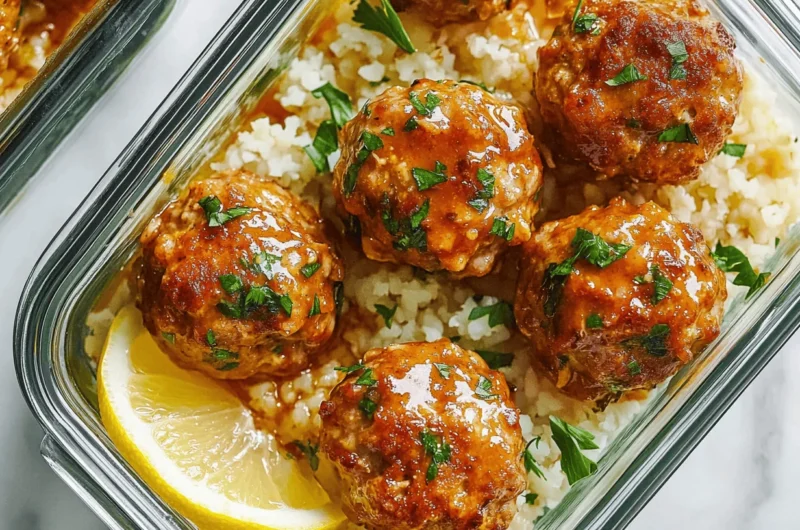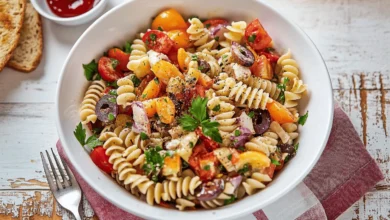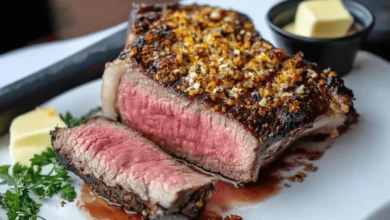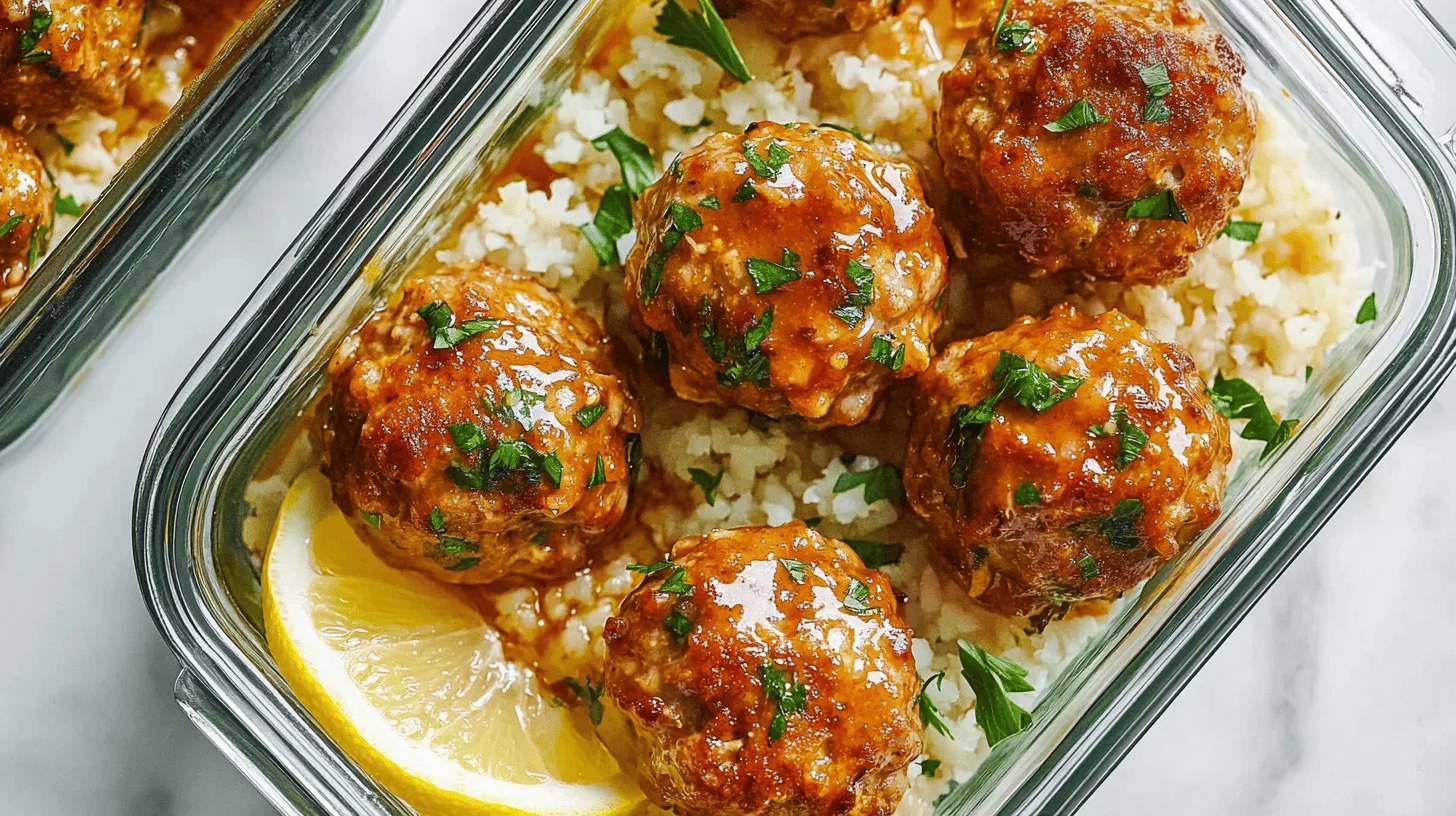
Meal Prep Garlic Butter Chicken Meatballs with Cauliflower Rice: 7 Secrets to Perfect Prep
Table of Contents
Within the labyrinthine corridors of modern existence, where time unfolds as our scarcest resource and nutrition often falls victim to convenience, there emerges a culinary solution that transcends mere sustenance. Meal Prep Garlic Butter Chicken Meatballs with Cauliflower Rice represents not simply a recipe but rather a gastronomic philosophy, an architectural framework for reclaiming the temporal dimensions of your week while simultaneously honoring the body’s fundamental need for nourishment that satisfies both physiological and sensory requirements.
The initial encounter with these meatballs reveals their multidimensional appeal. Tender spheres of ground chicken transformed through the alchemical marriage of aromatic garlic, melting cheese, and the subtle herbaceous notes of parsley, all enrobed in a silken butter sauce that defies the conventional limitations of meal preparation. What distinguishes this particular configuration of proteins, fats, and micronutrients is not merely its macronutrient profile but its remarkable resilience against the entropic forces that typically diminish prepared foods over time.
I recall vividly my first experiment with this recipe, skeptical that any preparation could maintain its integrity through the week’s chronological progression. Yet upon the Wednesday resurrection of Monday’s labor, I discovered not degradation but evolution. The flavors having engaged in a continued dialogue, deepening their relationship within the contained universe of my glass storage vessel.
When compared to my Crispy Fried Chicken Drumsticks, which demand immediate consumption to experience their textural perfection, these meatballs represent an alternative paradigm where patience yields dividends in both flavor development and life simplification.
I invite you to embark on this culinary journey. One that requires merely 25 minutes of temporal investment yet returns hours of freedom throughout your week while simultaneously elevating the quotidian experience of the midday meal from perfunctory necessity to anticipated pleasure.
What is Meal Prep Garlic Butter Chicken Meatballs?
Have you ever pondered the philosophical implications of a dish whose very nomenclature contains both its method of preparation and its destiny? Meal Prep Garlic Butter Chicken Meatballs exists within a fascinating linguistic intersection. Where verb meets noun, intention meets execution, and forethought manifests as delicious reality.
The etymological genealogy reveals itself through four distinct dimensions: the anticipatory preparation (“meal prep”), the transformative medium (“garlic butter”), the protein foundation (“chicken”), and the architectural form (“meatballs”). What other culinary creation so transparently declares its purpose from the moment of utterance? They say the way to a person’s heart is through their stomach, but perhaps the path to modern sanity is through prepared meals that whisper, “Relax, tomorrow’s nourishment has already been considered.”
When colleagues inquire about the aromatic contents of your lunch vessel, there’s a particular satisfaction in replying with a title that sounds like it emerged from a gourmet menu rather than your Sunday afternoon kitchen laboratory. Why not transform lunch from quotidian necessity to gastronomic event? Your taste buds and schedule will thank you for this delicious intervention into the temporal-culinary continuum.
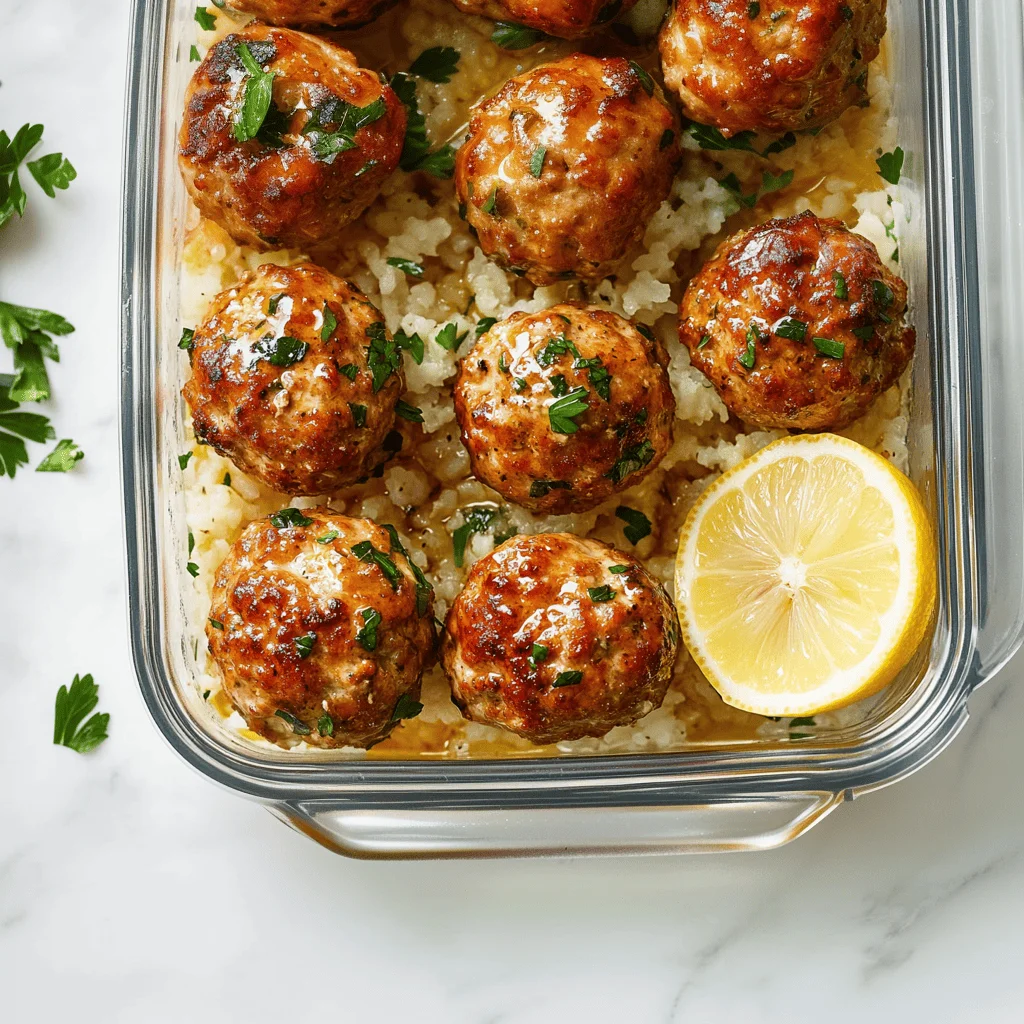
Why You’ll Love These Meal Prep Garlic Butter Chicken Meatballs:
A Symphony of Sustained Flavor
The primary transcendence of these Meal Prep Garlic Butter Chicken Meatballs lies in their remarkable resistance to the flavor degradation that typically plagues meal preparation endeavors. Unlike many protein preparations that surrender their sensory complexity upon refrigeration, these spherical creations maintain, perhaps even enhance, their flavor profile through time’s passage. This phenomenon occurs through a sophisticated interplay of complementary elements: the umami foundation of ground chicken, the aromatic complexity of fresh garlic, the subtle heat of chili flakes, and the lubricating richness of butter. The sauce, a carefully calibrated emulsion of butter, lemon, stock, and aromatics, continues to perfume the meatballs during storage, allowing the proteins to absorb these flavor compounds progressively. The experience on day three emerges not as a diminished echo of the original creation but as a fully realized evolutionary stage in the dish’s development. Where ingredients have achieved a harmonic convergence impossible in the immediate aftermath of cooking.
Economic Alchemy That Transforms Resources
Beyond the sensory dimensions lies a compelling economic calculus that reveals this recipe’s profound value proposition. A comparative analysis demonstrates its fiscal efficiency: while a similar restaurant offering would command approximately $14-18 per serving, this home preparation yields four complete meals at an approximate cost of $3.75-4.50 each, representing a 70-75% reduction in financial outlay. This economic efficiency extends beyond mere ingredient costs to encompass the broader resource economy of modern existence. Where time and cognitive bandwidth represent increasingly precious commodities. By consolidating cooking into a single 25-minute session rather than four separate preparations, you reclaim approximately 55 minutes of temporal resources throughout the week. This reclamation allows for reallocation toward pursuits of greater personal value, transforming cooking from daily obligation to strategic investment.
Nutritional Architecture That Supports Bodily Intelligence
The metabolic intelligence of this recipe reveals itself through careful macronutrient orchestration that supports physiological requirements while accommodating dietary parameters. By replacing traditional carbohydrate foundations with cauliflower rice, this preparation reduces total carbohydrate content by approximately 30-35 grams per serving compared to conventional rice preparations. This substitution maintains satiety through fiber enhancement while significantly reducing glycemic impact. The protein matrix, approximately 25-30 grams per serving, provides sustained amino acid availability that supports muscle maintenance and metabolic function throughout the afternoon without inducing the postprandial somnolence common to carbohydrate-heavy midday meals. The strategic inclusion of quality fats through butter and cheese creates a satisfaction mechanism that prevents premature hunger recurrence, allowing for sustained cognitive function throughout the afternoon work cycle.
When compared to my Best Korean Beef Bulgogi, which shares this recipe’s meal-prep friendliness but employs a different flavor architecture, these meatballs offer an alternative pathway to the same destination. Nourishing convenience that refuses to sacrifice gustatory pleasure on the altar of practicality.
I encourage you to experience this culinary temporal paradox yourself. Where minimal chronological investment yields maximum returns in both flavor satisfaction and schedule liberation. Your future self, encountering these meatballs mid-week, will recognize this preparation not merely as food but as an act of self-care translated into protein form.
How to Make Meal Prep Garlic Butter Chicken Meatballs:
Quick Overview
Meal Prep Garlic Butter Chicken Meatballs with Cauliflower Rice presents a paradigm shift in the conventional understanding of meal preparation. Where efficiency and flavor achieve perfect equilibrium rather than representing opposing forces. The textural juxtaposition of tender, succulent meatballs against the granular architecture of cauliflower rice creates a mouth-feel that satisfies primal eating pleasure while maintaining nutritional intelligence. The garlic butter sauce, silken, aromatic, and punctuated with brightness from lemon and depth from chicken stock, elevates this creation beyond mere meal preparation to culinary experience. Perhaps most remarkably, this symphony of flavor manifests in merely 25 minutes of actual culinary labor, making it accessible even within the constraints of the busiest weekend schedule, yet yielding four complete meals that maintain their integrity throughout the week’s progression.
ndition for 4-5 days, awaiting thermal reactivation via microwave energy when culinarily desired.
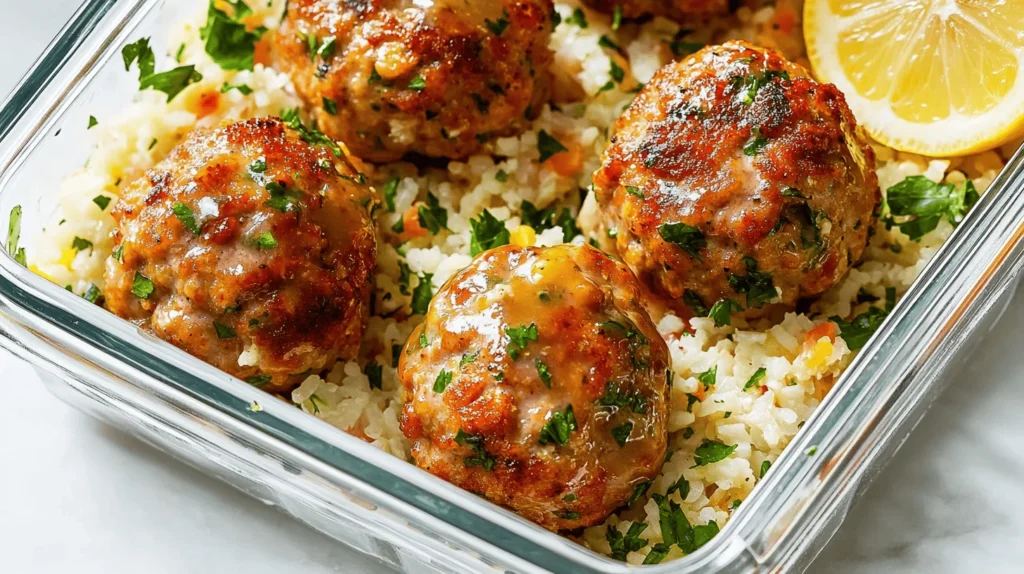
What to Serve Meal Prep Garlic Butter Chicken Meatballs With:
The beauty of this particular culinary configuration lies in its self-contained completeness. A harmonious balance of protein, vegetables, and sauce that requires no additional elements to satisfy nutritional or sensory requirements. However, for those seeking to expand the experiential dimensions of this preparation, several complementary pathways present themselves:
Verdant Accompaniments:
- Lemon-Dressed Arugula: The peppery articulation of fresh arugula, brightened with minimal lemon juice and high-quality olive oil, creates textural contrast while introducing fresh chlorophyll notes that complement the richness of the meatballs. This pairing works particularly well with my Salad with Steak preparation technique.
- Quick-Pickled Vegetables: A small portion of vegetables (cucumber, radish, red onion) subjected to fast-pickling methodology introduces acidic brightness and textural crunch that cuts through the buttery richness of the primary dish.
- Roasted Broccolini: The slight bitterness and structural integrity of broccolini subjected to high-heat roasting creates both flavor and textural counterpoint to the softness of the meatballs.
Alternative Carbohydrate Foundations:
- Zucchini Noodles: For those seeking to maintain low-carbohydrate protocols while introducing textural variety, spiralized zucchini briefly sautéed provides an alternative base with similar nutritional properties to cauliflower but distinct mouth-feel.
- Miracle Noodles: These konjac-derived translucent strands offer zero effective carbohydrate impact while providing a traditional pasta-adjacent experience for those who find the granular nature of cauliflower rice less satisfying.
- Quinoa Base: For those with higher energy requirements or who follow a moderate carbohydrate protocol, a quinoa foundation introduces complete protein supplementation and pleasant textural pop while still maintaining a favorable glycemic profile compared to traditional rice.
Flavor Enhancers for Day-of-Consumption Application:
- Fresh Herb Shower: A last-minute application of freshly chopped herbs (particularly cilantro, basil, or mint) introduces aromatic brightness that can revitalize preparations later in their storage life.
- Fermented Garlic Honey Drizzle: A small amount of garlic-infused honey that has undergone controlled fermentation introduces complex sweetness with probiotic benefits that transforms the flavor architecture of the dish.
- Artisanal Hot Sauce Accent: For heat enthusiasts, a few strategic drops of complex, fruit-forward artisanal hot sauce can recontextualize the dish with minimal effort.
These pairings have been suggested with consideration for both complementary flavor profiles and practical applications within the meal preparation paradigm, prioritizing options that maintain well during storage or can be quickly added upon consumption.
Top Tips for Perfecting Meal Prep Garlic Butter Chicken Meatballs:
1. The Philosophical Approach to Protein Selection
The foundation of transcendent meatballs begins with thoughtful consideration of your protein medium. While the recipe specifies ground chicken, this represents merely the starting point of a more nuanced decision tree. Standard ground chicken typically contains approximately 7% fat, sufficient for basic moisture retention but potentially leading to textural austerity by week’s end. Consider instead requesting from your butcher a custom blend of 80% chicken breast and 20% chicken thigh, which introduces additional intramuscular fat that acts as internal basting medium throughout both cooking and storage. For those unrestricted by poultry parameters, a blend incorporating 15-20% ground pork introduces collagen that converts to gelatin during cooking, creating a protective moisture matrix that maintains exceptional tenderness through extended storage. Those pursuing leaner protocols might explore the substitution of ground turkey breast supplemented with 1-2 tablespoons of olive oil worked into the mixture to compensate for reduced natural lipid content.
This protein selection should be considered in dialogue with the excellent Chicken Shawarma Bowl with Whipped Feta on my blog, where the alternative cooking methodology creates different texture considerations.
2. Temperature Moderation as Culinary Wisdom
Perhaps the most common pitfall in meatball preparation lies in excessive thermal application. Where the pursuit of appetizing exterior coloration leads to protein contracts and moisture expulsion. This becomes particularly problematic in meal preparation contexts, where moisture loss compounds through storage time. The solution requires embracing methodological patience: maintain your cooking surface at medium-low rather than medium-high temperature, allowing chromatic development (browning) to occur gradually while minimizing protein contraction. The target internal temperature should reach exactly 165°F (74°C), the food safety threshold for poultry, without unnecessary excess. Employing an instant-read thermometer removes guesswork from this process. For those practicing batch cooking of larger meatball quantities, consider the “reverse sear” approach: begin with a 325°F (163°C) oven application until an internal temperature of 155°F (68°C) is achieved, then finish with brief pan-searing for exterior development, allowing carryover cooking to reach final temperature without moisture sacrifice.
3. Binding Matrix Engineering
The structural integrity of meatballs, particularly critical in the context of meal preparation where they must withstand storage, transportation, and reheating, depends on proper binding matrix development. While the recipe employs cheese as the primary binding agent, several nuanced approaches can enhance this function:
- Panko Integration: The substitution of 2 tablespoons grated cheese with 2 tablespoons panko breadcrumbs (briefly soaked in 1 tablespoon milk) creates a spongiform internal architecture that absorbs and retains moisture throughout storage.
- Egg Yolk Application: The introduction of a single egg yolk (omitting the white, which can contribute to toughening) provides both lecithin for emulsification and protein for binding while enriching flavor.
- Temperature Staging: Allowing the formed meatballs to rest under refrigeration for 15-20 minutes before cooking allows protein strands to relax and binding agents to hydrate, significantly enhancing structural coherence during cooking.
4. Sauce Viscosity Calibration
The sauce component requires careful consideration of viscosity to function optimally in a meal preparation context. Too thin and it will run unappealingly during storage; too thick and it becomes difficult to distribute upon reheating. The ideal approach involves reduction to a specific visual cue: when the sauce reaches a consistency that momentarily parts when a spatula is drawn through it, revealing the pan bottom for 1-2 seconds before reunification, optimal viscosity has been achieved. If after the specified cooking time this threshold has not been reached, continue reduction; conversely, if over-thickening occurs, the careful introduction of 1-2 tablespoons additional stock can recalibrate. Remember that the sauce will thicken slightly upon cooling due to butter solidification, and may require a small liquid addition (1 teaspoon water or stock) when reheating if maximum silkiness is desired.
5. Cauliflower Rice Dehydration Protocol
The most frequent textural compromise in cauliflower-based preparations results from insufficient moisture management. Where excess water content creates sogginess that compounds during storage. Beyond the initial microwave preparation mentioned in the recipe, consider these advanced techniques:
- Cheesecloth Extraction: After initial cooking, transfer the cauliflower rice to a cheesecloth bundle and physically extract excess moisture through gentle twisting pressure.
- Dry-Sauté Finishing: Following initial cooking, transfer cauliflower rice to a non-stick pan and sauté over medium heat without additional fat for 2-3 minutes, allowing evaporation of surface moisture while maintaining internal tenderness.
- Absorption Enhancement: The addition of 1 tablespoon coconut flour or ground chia seeds to the cooked cauliflower rice creates microscopic moisture management through hydrocolloid properties that prevent weeping during storage.
6. Storage Vessel Selection Science
The container selection for meal preparation storage transcends mere convenience to become a critical variable affecting food quality throughout the week. Glass containers with locking lids offer superior performance across multiple dimensions:
- Thermal Stability: Glass permits microwave reheating without chemical leaching concerns associated with some plastics.
- Odor Resistance: Unlike plastic alternatives, glass does not absorb food aromas that can cross-contaminate future storage uses.
- Visibility Advantage: Transparent vessels allow visual assessment of food condition without breaking temperature-stabilizing seals.
- Compartmentalization: For optimal texture preservation, select containers with dividers that allow sauce separation until reheating is desired.
7. Reheating Methodology Optimization
The final variable affecting meal preparation success occurs at the moment of consumption. Where improper reheating can undermine previously perfect execution. The optimal approach varies by context:
- Office Microwave Protocol: If using shared microwave facilities of uncertain power, employ 70% power setting for 90 seconds, rest for 30 seconds (allowing heat redistribution), then apply 70% power for an additional 30-45 seconds. This prevents the temperature extremes that cause protein toughening.
- Home Reheating Luxury: When possible, separate components and reheat sauce gently on stovetop while warming meatballs and cauliflower rice in microwave, then recombine for optimal textural preservation.
- Cold Consumption Contingency: For situations where heating may be impossible, these meatballs remain texturally and flavorfully acceptable at room temperature (assuming proper food safety has been maintained), particularly when brightened with a fresh application of lemon juice and herbs.
Through these methodologically precise approaches, your meal preparation transcends mere sustenance to become a repeatable system of culinarily satisfying time reclamation.
Storing and Reheating Tips:
Storage Protocols for Optimal Preservation
The temporal extension of culinary creations requires methodological precision that balances food safety parameters with quality maintenance considerations. For these particular Meal Prep Garlic Butter Chicken Meatballs, several specific approaches warrant consideration:
Temperature Management Timeline:
- Initial Cooling Phase: Prior to refrigeration, allow the fully assembled meal components to cool at room temperature for precisely 20-30 minutes (but never exceeding the 2-hour food safety threshold). This controlled cooling prevents excess condensation formation within storage vessels that would otherwise compromise textural integrity.
- Primary Cold Storage: Once properly cooled, transfer immediately to refrigeration maintaining consistent temperature between 36-38°F (2-3°C), ideally positioned away from the refrigerator door to minimize temperature fluctuations during regular access.
- Consumption Window: While technically safe for consumption up to 5 days post-preparation, optimal sensory experience occurs within the 2-4 day window, with notable textural changes beginning approximately 96 hours after preparation.
Material Considerations for Containment:
- Preferred Vessel Composition: Borosilicate glass containers with silicone or locking gasket seals provide optimal performance through their non-reactive surface, excellent temperature tolerance, and superior airtight capabilities.
- Dimensional Parameters: Select shallow rather than deep containers whenever possible, as this geometry allows more efficient heat distribution during reheating while minimizing temperature gradients that can lead to uneven textural development.
- Compartmentalization Strategy: When available, employ divided containers that permit separate storage of sauce components until reheating, preventing premature sauce absorption that can compromise the distinct textural integrity of individual elements.
Additional Preservation Interventions:
- Ambient Oxygen Reduction: Before sealing storage vessels, gently press parchment paper directly onto the food surface to reduce air contact, minimizing oxidative processes that accelerate quality deterioration.
- Sauce Application Strategy: Consider storing approximately 25% of the sauce separately in miniature containers, allowing for fresh application post-reheating that creates perception of newly prepared rather than stored food.
- Freezing Contingency Protocol: Should unexpected schedule changes prevent consumption within the optimal window, these preparations freeze exceptionally well for up to 2 months when properly wrapped. The key intervention: slightly undercook meatballs by 1 minute before freezing to prevent overcooking during eventual reheating.
Reheating Methodologies for Sensory Optimization
The final critical juncture in meal preparation success occurs at the moment of consumption, where reheating methodology significantly impacts the ultimate sensory experience:
Microwave Restoration Technique:
- Remove container lid and cover with microwave-safe paper towel to control moisture release
- Apply 70% power for 90 seconds rather than full power, allowing gentler heat penetration
- Introduce a 30-second rest period, permitting thermal equilibration throughout the food mass
- Apply additional 30-45 seconds at 70% power until internal temperature reaches 165°F (74°C)
- After heating, allow 60 seconds covered rest before consumption to complete moisture redistribution
Office Environment Adaptations:
- For workplace settings with only basic microwave access, consider separating meatballs from cauliflower rice before reheating, as their differing density requires different thermal application times
- When separated reheating isn’t possible, arrange meatballs around the perimeter of the container with cauliflower rice concentrated in the center to account for the microwave’s uneven heating pattern
- A light sprinkle (approximately 1/2 teaspoon) of water over the surface before reheating creates steam that aids moisture retention
Thermal Regeneration Alternatives:
- Oven Recovery Method: When time permits, transferring components to an oven-safe dish and reheating at 325°F (163°C) for 12-15 minutes creates superior texture restoration compared to microwave methods
- Skillet Rejuvenation Approach: For home consumption, briefly reheating meatballs and sauce in a covered skillet over medium-low heat for 4-5 minutes creates a freshly-prepared sensation unattainable through other methods
- Cold Consumption Consideration: It’s worth noting that these particular meatballs maintain acceptable flavor profiles even when consumed at room temperature (assuming proper food safety has been maintained), offering solution for environments without heating capabilities
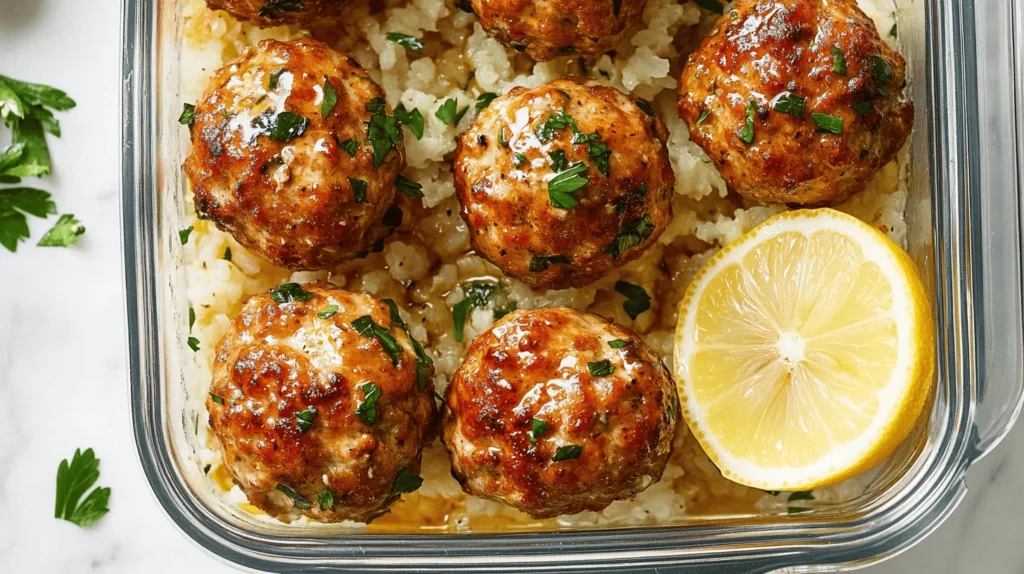
Post-Heating Sensory Enhancements:
- A final drizzle of extra virgin olive oil (approximately 1 teaspoon) after reheating introduces fresh lipid aromatics that create perception of newly prepared food
- The application of acid brightness through a few drops of fresh lemon juice reinvigorates flavor compounds that may have mellowed during storage
- A strategic dusting of freshly chopped herbs (particularly parsley, chives, or cilantro) immediately before consumption introduces aromatic complexity that transcends the meal preparation paradigm
Through these methodologically precise interventions, meal preparation transcends its utilitarian function to become a system of culinary excellence that refuses to sacrifice gustatory pleasure in service of convenience.
Meal Prep Garlic Butter Chicken Meatballs with Cauliflower Rice
Course: Uncategorized4
servings30
minutes40
minutes300
kcalIngredients
- For the Meatballs:
1 lb (450g) ground chicken (or turkey)
1/2 cup shredded cheese of your choice (mozzarella, cheddar, provolone)
4 cloves garlic, grated + 2 cloves garlic, minced
1 teaspoon Italian seasoning
1/2 teaspoon red crushed chili pepper flakes, optional
1 crumbled bouillon cube, optional
1/2 cup chicken stock
Salt and fresh cracked black pepper, to taste
1/2 cup fresh chopped parsley (or cilantro)
- For the Sauce and Base:
3 tablespoons butter, divided
Juice of 1/2 lemon
1 tablespoon hot sauce of your choice (Sriracha recommended)
1 medium cauliflower head, grated (or a packet of pre-riced cauliflower)
Step-by-Step Instructions:
- Prepare the Cauliflower Foundation
Begin by transforming the architectural structure of the cauliflower. Converting it from its natural floreted form into a rice-like granular substrate. This metamorphosis can be achieved through either the mechanical application of a food processor’s pulse function or the more meditative approach of manual grating. The resulting rice-like particles should then be transferred to a shallow vessel, hydrated with approximately 1/2 cup water, and subjected to microwave radiation for precisely 4 minutes while covered. This preliminary cooking achieves two objectives: it softens the cellular structure of the cauliflower while simultaneously allowing excess moisture to be released and subsequently drained, preventing future sogginess in your final preparation. - Compose the Meatball Matrix
While the cauliflower undergoes its transformation, direct your attention to the creation of the protein component. In a vessel of sufficient volume, orchestrate the convergence of ground chicken, your selected cheese variety, the aromatic intensity of grated garlic, the herbaceous notes of Italian seasoning, the structural reinforcement of the crumbled bouillon (if employing), the optional heat dimension of red pepper flakes, the brightness of chopped parsley or cilantro, and freshly fractured black pepper. This assemblage should be harmonized through gentle manipulation, either digital (with hands) or mechanical (with fork), until the ingredients achieve cohesion without excessive compaction, which would compromise textural integrity. From this unified protein canvas, extract and form spherical bodies of moderate dimension, arranging them on a waiting surface for their impending thermal transformation. - Execute Thermal Transformation of Protein Spheres
Introduce 2 tablespoons of butter to a skillet of appropriate dimension, allowing it to liquefy under medium-low thermal conditions. Once the butter achieves liquid state with slight bubbling activity, introduce the protein spheres to this lipid medium. Allow them to undergo thermal processing for approximately 8-10 minutes, ensuring rotational movement to achieve chromatic transformation (browning) on all exterior surfaces while simultaneously ensuring internal temperature achievement sufficient for food safety protocols (165°F/74°C). Throughout this process, employ the technique of basting, redirecting the accumulating butter and released juices over the spheres to enhance moisture retention and flavor penetration. Upon completion, relocate these transformed protein bodies to a clean waiting surface, temporally suspending their participation in the recipe sequence. - Formulate the Sauce Medium
Maintaining the same culinary vessel, now enriched with the flavor compounds released during protein cooking, introduce the remaining tablespoon of butter, allowing it to join the existing lipid medium. Upon liquefaction, orchestrate the integration of lemon juice, chicken stock, your selected capsaicin delivery system (hot sauce), the minced garlic reserved from earlier preparation, additional herbaceous elements (parsley), and if desired, further heat components (red pepper flakes). Subject this liquid composition to thermal reduction for approximately 3-4 minutes, maintaining regular agitation to ensure emulsification. During this process, taste evaluation should occur, allowing for potential sodium and pepper adjustments to achieve ideal flavor balance. - Architectural Assembly and Storage Strategy
The final phase requires the strategic distribution of components across your selected containment vessels (preferably glass for both environmental and food safety considerations). Begin with the cauliflower foundation, creating a carbohydrate-minimal base layer in each vessel. Upon this foundation, position your protein spheres in an aesthetically pleasing arrangement, introducing visual accent through thin citrus cross-sections. The sauce element should either be drizzled with artistic intention over the existing components or, if texture preservation is prioritized, sequestered in separate miniature containment vessels for later application. Seal these compositional arrangements and relocate to refrigerated storage, where they may remain in optimal condition for 4-5 days, awaiting thermal reactivation via microwave energy when culinarily desired.
Nutrition Facts
- Calories: 325 kcal | Total Fat: 22 g | Saturated Fat: 10 g | Trans Fat: 0 g | Cholesterol: 115 mg | Sodium: 680 mg | Total Carbohydrates: 8 g | Dietary Fiber: 3 g | Sugars: 3 g | Protein: 28 g | Vitamin D: 0.3 mcg | Calcium: 135 mg | Iron: 2.0 mg | Potassium: 540 mg
The Philosophical Dimensions of Meal Preparation
Beyond the mechanical execution of this recipe lies a deeper consideration. The way in which meal preparation represents a peculiarly modern response to the temporal dilemmas of contemporary existence. In a world increasingly characterized by the paradoxical combination of time scarcity and food abundance, the act of meal preparation becomes a philosophical stance. A deliberate reclamation of both nutritional autonomy and temporal sovereignty.
The Sunday afternoon spent crafting these meatballs represents more than mere cooking; it becomes an act of intentional resistance against the forces of convenience that would extract both financial resources and nutritional control. The 25 minutes invested yields not just physical sustenance but psychological nourishment. The profound satisfaction of having solved a logistical puzzle that plagues modern existence. Each container, arranged with care in the refrigerator, becomes a tangible manifestation of forethought made edible.
This approach finds resonance in various philosophical traditions. From the Stoic practice of preparing for future contingencies to the Buddhist mindfulness of honoring food’s life-sustaining properties through attentive preparation. The meal prepper finds unlikely kinship with both ancestral wisdom that preserved harvest abundance and futurist efficiency that optimizes resource utilization.
As you incorporate this recipe into your own culinary repertoire, consider that you’re engaging in more than food production. You’re participating in a quiet revolution that reasserts control over both nutritional intake and temporal experience in a world that increasingly attempts to commodify both.
For future explorations in meal preparation philosophy and practice, I encourage you to visit authoritative culinary preparation resources like Meal Prep Society and EatingWell’s Meal Prep Guide, which offer expanded perspectives on this transformative approach to modern eating.
FAQ: Meal Prep Garlic Butter Chicken Meatballs
Q: Can I substitute ground turkey for the chicken in this recipe? A: Absolutely. Turkey functions as a nearly identical analog in this culinary application, though with subtle textural differences. If using lean turkey (99%), consider adding 1 tablespoon olive oil to compensate for the reduced fat content, maintaining optimal moisture levels through the storage period.
Q: How can I make this recipe dairy-free? A: The dairy components can be elegantly replaced with minimal compromise to the final result. Substitute the cheese with 2 tablespoons nutritional yeast plus 1 tablespoon almond flour to maintain umami depth and binding properties. Replace butter with either ghee (if merely lactose-intolerant) or a high-quality olive oil combined with a teaspoon of coconut oil for appropriate mouthfeel.
Q: Can I freeze these meatballs for longer-term storage? A: Indeed, these particular meatballs respond exceptionally well to freezing protocols. For optimal results, slightly undercook the meatballs by about 1 minute, allow to cool completely, then freeze on a parchment-lined tray before transferring to airtight containers. This prevents clumping and allows for selective thawing. Properly stored, they maintain quality for approximately 2-3 months.
Q: My meatballs tend to fall apart during cooking. What am I doing wrong? A: This structural failure typically stems from insufficient binding matrix development. Ensure cheese is fully incorporated throughout the mixture, consider adding an egg yolk as supplemental binder, and perhaps most crucially, allow the formed meatballs to rest under refrigeration for 15-20 minutes before cooking, which allows protein strands to relax and binding agents to fully hydrate.
Q: What can I use instead of cauliflower rice if I don’t enjoy its texture? A: Several compelling alternatives exist depending on your dietary parameters. Miracle rice (konjac-based) offers almost zero effective carbohydrates with a more traditional rice-adjacent texture. Quinoa provides a more traditional grain experience with moderate carbohydrate impact and complete protein profile. Finely diced sautéed cabbage offers similar nutritional properties to cauliflower but with distinct textural qualities that some find more appealing.
Q: How do I prevent the sauce from separating during storage? A: The emulsion stability of the sauce benefits from methodological precision. Ensure butter has fully incorporated with other liquid elements before removing from heat, and consider the addition of 1/4 teaspoon Dijon mustard, which contains natural emulsifiers that significantly improve stability. If separation does occur during storage, a vigorous stirring during the reheating process will generally restore the emulsion to acceptable condition.
Q: Can this recipe be doubled for larger family meal prep? A: The proportions scale linearly with excellent results, though several adjustments warrant consideration. When doubling, cook meatballs in two separate batches rather than crowding the pan, which would impede proper browning. The sauce reduction time will need to be extended by approximately 2-3 minutes to achieve proper viscosity with doubled liquid volume. Additionally, consider increasing aromatic elements (garlic, herbs) by only 75% rather than a full 100% to maintain balanced flavor profiles.
Q: What’s the best way to transport these to work without leakage concerns? A: Transport optimization requires strategic container selection. Look for vessels with silicone gasket seals that create hermetic closure, preventing liquid migration. Additionally, when preparing specifically for transport scenarios, consider reducing sauce volume by an additional 1-2 minutes during cooking to achieve slightly thicker consistency. Finally, positioning containers upright in transport bags and filling them only 80-85% of maximum capacity creates additional insurance against potential leakage.
Q: Can I use pre-made meatballs to save time? A: While commercial meatballs provide temporal efficiency, they represent a significant compromise to the final culinary experience. Most commercial varieties contain substantial fillers, excessive sodium, and preservatives that fundamentally alter both flavor profile and texture stability during storage. If absolute time minimization is required, consider preparing and freezing a large batch of homemade meatballs during a dedicated cooking session, which allows quality maintenance while providing the convenience of pre-made options.

